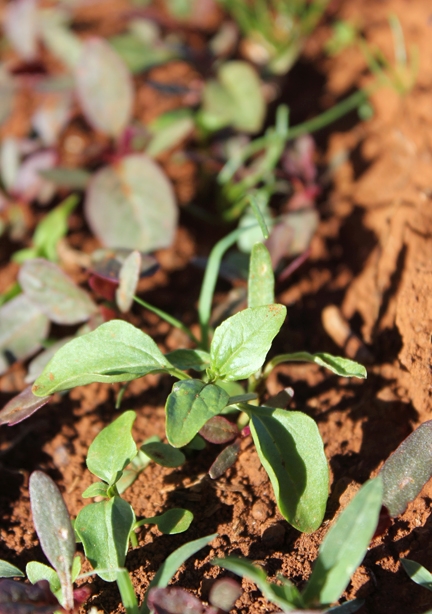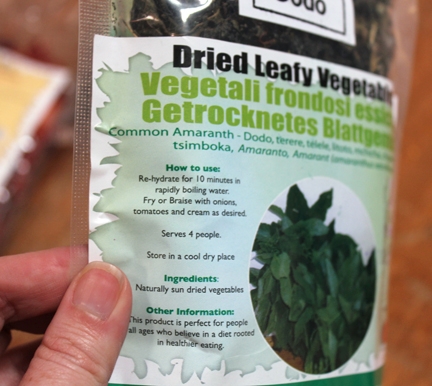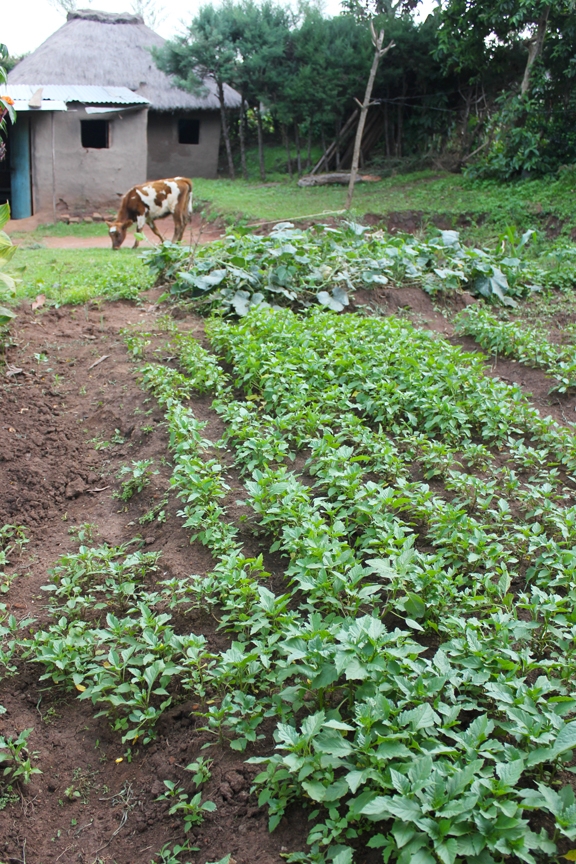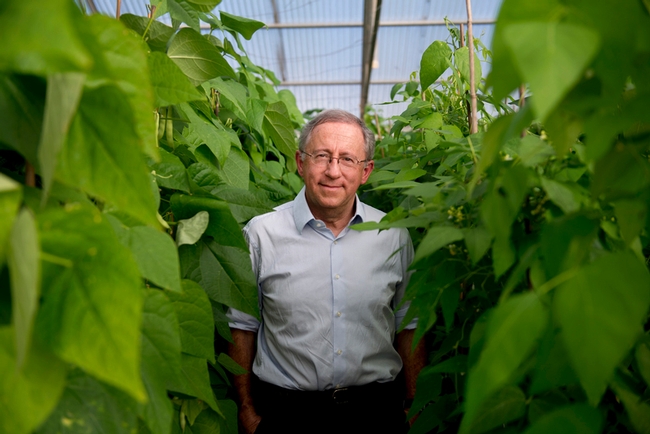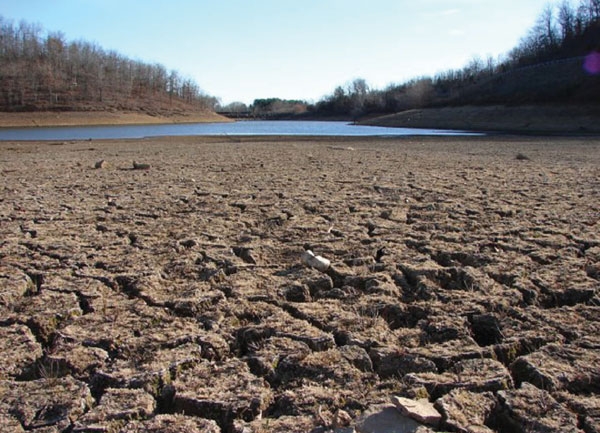UC Food and Agriculture Blogs
When weeds make good eats
Last week, NPR offered up a novel weed control solution for all those yellow dandelions dotting your lawn: just eat 'em. The article includes a chef's recipe for dandelion flower fritters.
The idea that weeds can be edible pops up periodically, with articles suggesting one person's weeds are another person's salad bar, highlighting chefs who “have a way with weeds,” discussing ways medieval gardeners encouraged weeds, and even suggesting ways to eat away at invasive species. But is this something we should take seriously?
“We call these plants weeds because of the way we interact with them. They're in our gardens, they're in our lawns, and they're competing with plants that we prefer to eat,” said Lynn Sosnoskie, a weed scientist at UC Davis. “But a lot of the plants that are weeds here in the United States were brought here purposefully—to be eaten.”
Sosnoskie's doctoral thesis was on just such a plant, with the tasty name of “garlic mustard.” She has also worked at length on Palmer amaranth, a pernicious weed found in cotton fields that can be glyphosate-resistant. In response to one Georgia farmer asking in exasperation if he should just eat the plant taking over his fields, she did some preliminary research into eating Palmer amaranth.
“It's probably not feasible to eat our way out of a serious weed problem,” she said. “But I certainly feel like we can investigate them as other potential food sources.”
In fact, the Horticulture Innovation Lab at UC Davis has a project that is researching three “indigenous vegetables” in Africa, two of which — amaranth and black nightshade — are considered weeds in the United States. The vegetables can be nutritious and profitable options for small-scale farmers in Kenya, Tanzania, Zambia and elsewhere.
“I think some of these weeds have a lot of potential and are underutilized,” said Stephen Weller, horticulture professor at Purdue University, who leads the indigenous vegetables project. “In eastern Africa, these vegetables are very popular. And I really think that as we get more immigrants here from that region, there is going to be a market for some of these vegetables here.”
Though he holds a Ph.D. in weed science, Weller is now figuring out the best ways to cultivate amaranth and black nightshade — instead of to eliminate them. Before he started working with these plants, common assumptions held that they should be easy to grow because, well, they “grow like weeds.”
“But we found out that growing them is more intensive than we were initially led to believe — similar to growing any other vegetable,” Weller said. “They need water, they need fertilizer, and pests are a problem.”
Caveat emptor: Though weedy plants can indeed be a source of food, both scientists cautioned against thinking of weeds as a “free-for-all forage buffet.” Some plants may be toxic, and weeds in farm fields may have been sprayed recently. It is important to be knowledgeable of the plants and how they've been grown before trying to eat one.
What's that Spider?
There are many different types of spiders inhabiting homes and gardens in California. Most spiders are harmless and serve a beneficial role by catching and killing pest insects. Find out how to identify common spider groups by reading the Pest Note:...
Nothing common about these beans
As you're ladling up country-style pinto beans for your weekend barbecue or fixing a cold three-bean salad from kidney, string and navy beans for a summer picnic, pause to remember what a long and storied history these “common bean” varieties share and the new scientific advances that promise to boost their productivity worldwide.
This week, a new genome sequencing is being reported for the common bean, which ranks as the world's 10th most widely grown food crop and includes the culinary favorites above, whose varieties together comprise a $1.2 billion crop in the United States.
“The availability of this new whole-genome sequence for beans is already paying off,” said Paul Gepts, professor in the Department of Plant Sciences at UC Davis and co-author of the new sequencing study.
Gepts, who leads the bean-breeding program at UC Davis, notes that the new sequence is being used to confirm many of the findings made earlier by his UC Davis research group, including identification of the common bean's two points of origin and domestication.
Sequencing and bean ancestry
The common bean is thought to have originated in Mexico more than 100,000 years ago, but -- as the Gepts group earlier discovered – was domesticated separately at two different geographic locations in Mesoamerica and the southern Andes.
“This finding makes the common bean an unusually interesting experimental system because the domestication process has been replicated in this crop,” Gepts said.
The sequencing team compared gene sequences from pooled populations of plants representing these two regions and found that only a small fraction of the genes are shared between common bean species from the two locations. This supports the earlier finding that the common bean was domesticated in two separate events -- one at each location -- but distinct genes were involved in each event.
The new whole-genome sequencing is also helping to identify genetic “markers” that can be used to speed up breeding of new and more productive bean varieties in the United States, East Africa and elsewhere, Gepts said.
The nitrogen connection
All of bean varieties that belong to the “common bean” group share with the closely related soybean the highly valued ability to form symbiotic relationships with “nitrogen-fixing” bacteria in the soil.
The plants and the bacteria work together to convert nitrogen in the atmosphere into ammonia – which includes nitrogen in a form that enriches the soil and feeds crops. Nitrogen-fixing crop plants can actually reduce or eliminate the need for farmers to apply expensive fertilizers.
One goal of the new sequencing project was to better understand the genetic basis for how such symbiotic relationships between nitrogen-fixing plants and bacteria are formed and sustained, with an eye toward increasing fuel- and food-crop productivity.
The research team successfully identified a handful of genes involved with moving nitrogen around, which could be helpful to farmers who intercrop beans with other crops that don't fix nitrogen.
Findings from this study are reported this week online in the journal Nature Genetics. The sequencing project was led by researchers at the University of Georgia, U.S. Department of Energy Joint Genome Institute, Hudson Alpha Institute for Biotechnology and North Dakota State University.
Elm Leaf Beetle: A Major Pest is Now Uncommon
Elm leaf beetles frequently defoliated elm trees in landscapes, parks and along streets in the 1970s, 1980s and mid 1990s, eliminating shade and weakening these important components of California's urban forests. Fortunately, the elm leaf beetle has been...

Third instar larva of elm leaf beetle and feeding damage.
From drought to farmers to food prices
Driving along California's freeways, it is hard to miss the electronic signs urging people to save water due to the serious drought. Rain, when it comes, is unevenly spread across the state, with the Central Valley — home to California's most productive agricultural areas — being especially vulnerable to this irregularity.
The drought is now so severe that in April Governor Jerry Brown called upon “all Californians, municipal water agencies, and anyone who uses water to do everything possible to conserve.” Just days earlier, University of California President Janet Napolitano paid a special visit to California's heartland to explore how universities could assist.
How might this drought affect food prices? Milton McGiffen, UC Cooperative Extension specialist in the department of Botany and Plant Sciences at UC Riverside, says the greatest impact would indeed be on produce coming from the Central Valley — tomatoes and melons, for example.
"Citrus prices have increased due to the big freeze last December,” he said.“With scarcity of water comes higher water cost, which could result in farmers opting to grow higher value crops, such as fruits and nuts. It's no accident that the cost of a bag of walnuts recently went up about 36 percent at Costco. Research is just beginning now on how some farmers are selling off their farms because of the adverse water situation.”
McGiffen points also to growing urbanization in California as another factor.
“There is a conflict between land and water use for growing food or growing cities,” he says. “It comes down to how much we want to see agriculture continuing in the state. It depends, too, on how much we want to charge farmers for water. In Riverside County, farmers got a break in water charges until the late 1980s. After that, they were charged the same amount for water as were homeowners. It became unsustainable for them, and many farmers simply left the region.”
Americans spend about 6.6 percent of their household income on food — by far one of the lowest in the world. McGiffen calculates that if food prices were to increase by 20 percent, Americans would end up spending an extra 1 percent of their household income on food.
“In real terms, will this change how we behave? I'd say probably not. Like lobsters in a slowly heated pot, we will adapt," McGiffen said. "But we cannot afford to forget that we need to produce significant amounts of food. Failing at this would put us at a major disadvantage. Currently, about half of our food comes from other countries — Latin American countries, in particular. We certainly don't want to increase that.”



